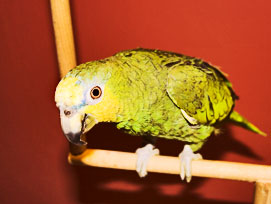
It’s become a lot easier to breed Amazon parrots in the last few years. There are now scientifically formulated diets, safe procedures for verifying the birds’ gender, and proven techniques for raising hatchlings.
Amazon Breeding-Choosing breeding stock
Wild birds don’t really make good breeding stock because they are too agitated or unused to captivity that they fail to mate or raise hatchlings. Choose from domesticated stock, since they used to human beings and are more likely to get used to being in flight cages.
It’s best if the pair were raised together to begin with, since they are familiar with each other. Amazon parrots must at least be 3 years old before they are mated.
Some pairs will simply refuse to mate. This is a compatibility issue and can easily be remedied by matching them with other birds. You can also change environment. They may be bothered by something (like the noise of construction in the next lot). Be more wary of birds with a history of attacking its eggs or destroying eggs, since the problem may be deep-rooted and may not easily be corrected.
Amazon Breeding-Breeding nests
Amazon parrots need large breeding flights. This will allow them to exercise, avoiding the common problem of obesity, and resulting in healthier parents (and healthier hatchlings!). Most avicuturalists recommend using suspended flights, measuring 6 to 12 feet long and 3 to 4 feet wide. They should be hung as high above the ground as possible, at least at human eye level. Wood boxes are much better than metal boxes, which tend to be either too hot or too cold.
If you are breeding more than one pair of Amazons, keep the cages apart but still near enough so they can hear each other’s mating calls. This can help “inspire” a pair to begin breeding, or at least give a sense of security from knowing that the place is safe enough to raise young.
However, avoid placing cages so close together that the birds can see each other, which can cause territorial aggression. If space is a problem, separate cages with aluminum sheets.
Amazon Breeding-Diet
Give a pellet diet with vegetables and grains for variety. Red wheat, lentils and beans can help increase protein levels, while carrots and sweet potatoes are a rich source of energy. Limit seeds since the high fat can lead to obesity, which becomes a bigger problem during breeding season.